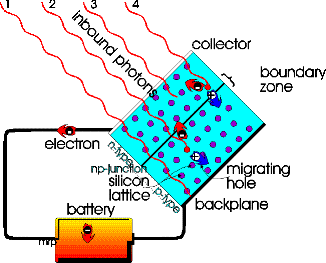How Solar Cells Work
 In the 1950s scientists tinkering with
semiconductors found that by introducing small, minutely controlled amounts of certain
impurities called dopants to the semiconductor matrix, the density of free electrons could
be shepherded and controlled. The dopants, similar enough in structure and valence
to fit into the matrix, have one electron more or less than the semiconductor; for
example, doping with phosphorus, which has five valence electrons, produces a (negative)
n-type semiconductor, with an extra electron which can be dislodged easily.
Aluminum, boron, indium, and gallium have only three valence electrons, and so a
semiconductor doped with them is (positive) p-type, and has holes" where the missing
electrons ought to be. These holes behave just like electrons, except that they have
an opposite, positive charge. (Holes are theoretical, but so are electrons, and
either or both may or may not exist, but we know for sure that if one exists, they both
do, because we can't create something out of nothing in the physical world.) It is
important to understand that, although loosely bonded or extra carriers exist in a
substance, it is still neutral electrically, because each atom's electrons are matched one
for one by protons in the nucleus.
In the 1950s scientists tinkering with
semiconductors found that by introducing small, minutely controlled amounts of certain
impurities called dopants to the semiconductor matrix, the density of free electrons could
be shepherded and controlled. The dopants, similar enough in structure and valence
to fit into the matrix, have one electron more or less than the semiconductor; for
example, doping with phosphorus, which has five valence electrons, produces a (negative)
n-type semiconductor, with an extra electron which can be dislodged easily.
Aluminum, boron, indium, and gallium have only three valence electrons, and so a
semiconductor doped with them is (positive) p-type, and has holes" where the missing
electrons ought to be. These holes behave just like electrons, except that they have
an opposite, positive charge. (Holes are theoretical, but so are electrons, and
either or both may or may not exist, but we know for sure that if one exists, they both
do, because we can't create something out of nothing in the physical world.) It is
important to understand that, although loosely bonded or extra carriers exist in a
substance, it is still neutral electrically, because each atom's electrons are matched one
for one by protons in the nucleus.
The fun begins when the two semiconductor types are intimately joined in a pn-junction, and the carriers are free to wander. Being of opposite charge, they move toward each other, and may cross the junction, depleting the region they came from, and transferring their charge to their new region. This produces an electric field, called gradient, which quickly reaches equilibrium with the force of attraction of excess carriers. This field becomes a permanent part of the device, a kind of slope that makes carriers tend to slide across the junction when they get close.
When light strikes a Photovoltaic cell, atoms are bombarded with photons, and give up electrons. When an electron gets lopped off an atom, it leaves behind a hole, which has an equal and opposite charge. Both the electron, with its negative charge, and the hole, with its positive charge, begin a random walk generally down the gradient. If either carrier wanders across the junction, the field and the nature of the semiconductor material discourage it from recrossing. A proportion of carriers which cross this junction can be harvested by completing a circuit from a grid on the cell's surface to a collector on the back plane. In the cell, the light pumps" electrons out one side of the cell, through the circuit, and back to the other side, energizing any electrical devices (like the battery in the diagram) found along the way.
This information was reprinted from The Independent Home, by
Michael Potts.
Shop Our Entire Storefront Securely Here.

Big Frog Mountain brings you ENERGY
STAR©
ENERGY
STAR qualified products use less energy than conventional products. And money isn't all you're saving by purchasing products that use less energy, you're also helping to save the environment.
As an ENERGY
STAR partner, Big Frog Mountain is proud to offer you products with the ENERGY
STAR label. For more information, visit www.energystar.gov

Home | About Us | FAQ | Glossary | Photo Tour | Projects | Links | Ordering Information | Large Solar Packages | Small Solar Packages | Contact Us
Energy Worksheet | Voltage Drop Chart | Calculators | Power Consumption Guide | How Solar Works
PowerFilm® | Engel® 12V Fridges/Freezers/Warmers | VELUX® Sun Tunnels | Natural Light® Solar Attic Fans | Staber® Efficient Appliances | SunDanzer® Solar Powered Refrigerators/Freezers
© 1997-2013
Big Frog Mountain Corporation
3821 Hixson Pike
Chattanooga, Tennessee 37415
(423) 265-0307 M-F 9-5 Eastern
1-877-232-1580 Toll-Free Order Line
(423)-265-9030 FAX 24/7